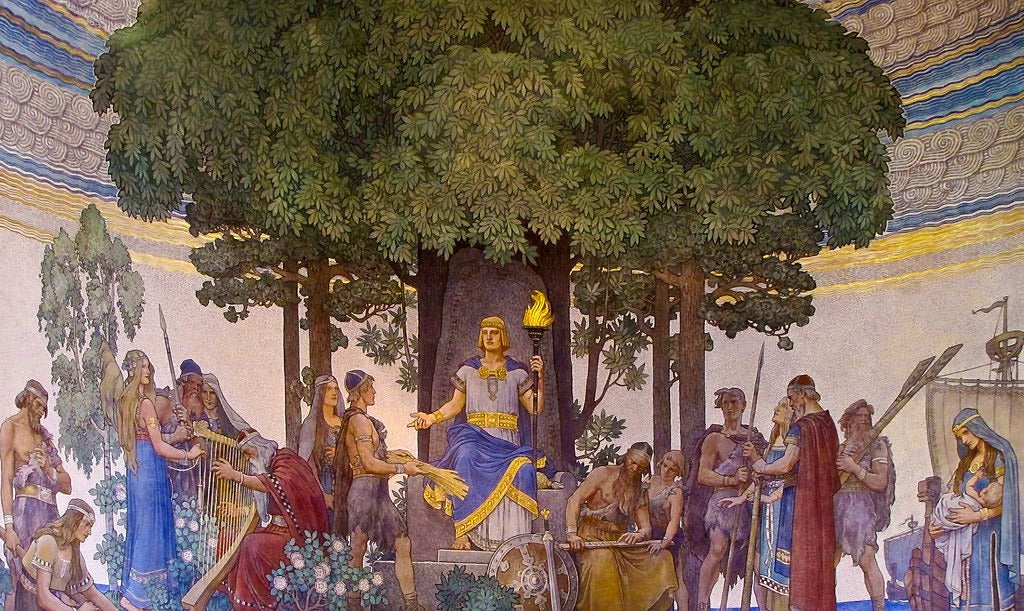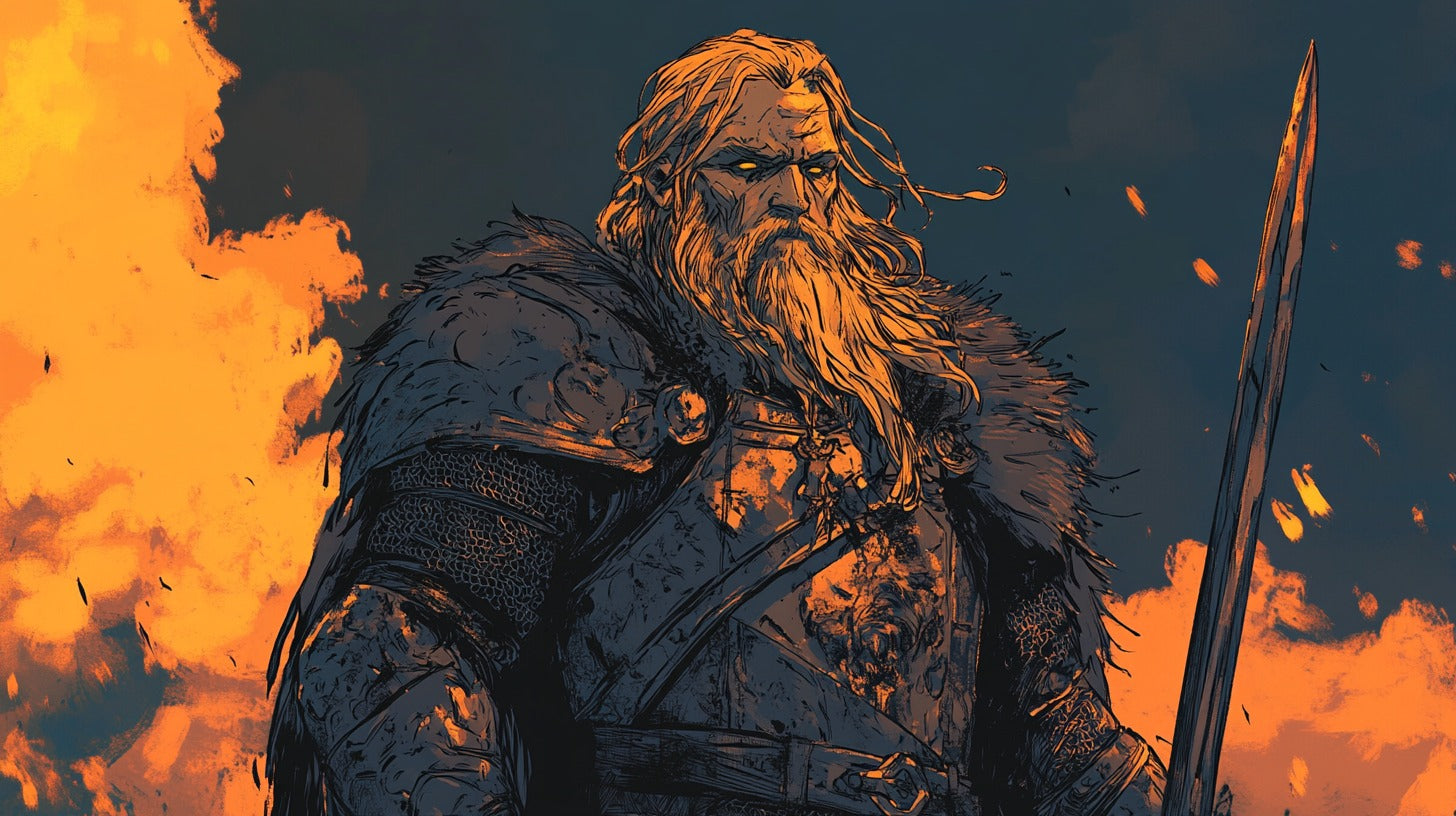
Heimdall: Guardian of the Gods in Norse Mythology
In Norse mythology, Heimdall (Old Norse: Heimdallr) stands as one of the most enigmatic and significant deities, renowned as the vigilant guardian of Asgard and the watchman of the gods. Known for his acute senses and unwavering dedication to protecting the divine realm, Heimdall's role extends far beyond mere sentinel duty. His influence permeates through the cosmic layers of Norse mythology, from the highest branches of Yggdrasil to the depths of human society, marking him as a figure of profound importance in the Norse mythological tradition.
Origins and Etymology

Rig in Great-grandfather's Cottage (1908) by W. G. Collingwood
Name Analysis
The name Heimdallr derives from Old Norse, combining "heimr" (world, home) and "dallr" (bright, shining). Linguistic scholars, including Rudolf Simek, have extensively studied the etymology, revealing layers of meaning that illuminate his cosmic significance. Beyond the basic translation of "the one who illuminates the world," deeper analysis suggests connections to ancient Indo-European root words relating to both cosmic pillars and divine illumination. This complexity in his name reflects the multifaceted nature of his divine role within the Norse pantheon.
Historical References
The primary sources mentioning Heimdall emerge from medieval Icelandic literature, particularly the Poetic Edda's Völuspá and Grímnismál, which provide vivid descriptions of his attributes and duties. Snorri Sturluson's Prose Edda offers additional layers of detail and interpretation. These 13th-century texts, while written in the Christian era, preserve much older oral traditions about Heimdall's role. Earlier runic inscriptions and archaeological findings suggest his worship predated these written accounts by several centuries, though exact dating remains challenging for scholars.
Characteristics and Attributes
Ancient texts describe Heimdall as the White God (hvíti áss), characterized by his gleaming teeth made of gold, known as Gullintanni. His exceptional senses include the ability to hear grass growing on the earth and wool growing on sheep. Beyond these physical attributes, Heimdall possesses the gift of foresight comparable to the Vanir gods, requiring less sleep than a bird to maintain his eternal vigilance. His possession of Gjallarhorn, the resounding horn, marks him as the herald of Ragnarök, the twilight of the gods.
Mythological Role

Heimdall & Gjallarhorn Ragnarok Pendant
Guardian of Bifröst
From his dwelling Himinbjörg ("heaven's castle"), Heimdall maintains constant vigilance over Bifröst, the rainbow bridge connecting Midgard with Asgard. His position as guardian represents more than physical defense – he stands as the mediator between divine and mortal realms, maintaining cosmic order through his watchfulness. His acute senses serve as the first line of defense against the giants and other threats to divine order, making him indispensable to the security of Asgard.
Ragnarök Prophecy
The prophecy of Ragnarök places Heimdall at a crucial juncture in cosmic history. As the final battle approaches, he shall sound Gjallarhorn, its blast reaching all corners of the nine worlds. The texts foretell his ultimate confrontation with Loki, resulting in their mutual destruction. This prophesied end highlights the eternal opposition between the watchful protector and the chaos-bringer, a fundamental tension in Norse mythology.
Family and Relationships
The Prose Edda presents an unusual origin story, describing Heimdall as the son of nine mothers, all sisters. Scholarly interpretation suggests these mothers represent personified waves of the sea, indicating a deep connection between Heimdall and primordial forces. His relationship with Odin positions him as a loyal servant to the Allfather, while his antagonism with Loki represents the cosmic struggle between order and chaos. The complex tale of recovering Freyja's Brísingamen necklace demonstrates his role as both protector and enforcer of divine will.

Part of the Gosforth Cross panel assumed to depict Heimdall with Gjallarhorn
Major Myths
The recovery of Freyja's Brísingamen stands as one of Heimdall's most significant myths. This tale showcases not only his combat prowess but his cunning, as he outsmarts Loki to retrieve the stolen necklace. The Rígsþula presents another crucial myth, attributing to Heimdall (as Rígr) the creation of social classes in Norse society. Through his travels and relationships with humans, he establishes the divisions between thralls, karls, and jarls, fundamentally shaping Norse social structure.
Archaeological Evidence
Material culture from the Viking Age provides tangible connections to Heimdall worship. Picture stones and runestones dated between 793-1066 CE show figures and scenes that scholars interpret as Heimdall-related imagery. The most comprehensive textual sources come from medieval Icelandic manuscripts, including the Codex Regius and the Uppsala Edda. These documents, while later compilations, preserve older oral traditions and religious practices centered around Heimdall's worship.

The Saltfleetby spindle whorl from Lincolnshire, England, potentially inscribed with the name of the Norse god Heimdall (Photo: Portable Antiquities Scheme CC BY 2.0).
Cultural Impact
Heimdall's influence extends into modern culture through various mediums of artistic and literary expression. His character has inspired countless reinterpretations in literature, visual arts, and popular media. Modern religious movements, particularly those reviving Norse traditions, continue to honor Heimdall as a symbol of vigilance and protection. His enduring legacy speaks to the timeless appeal of his role as guardian and protector.
Conclusion
Heimdall represents a unique figure in Norse mythology, embodying vigilance, protection, and social order. His complex character and multifaceted roles provide vital insight into the sophisticated religious and social structures of medieval Scandinavian society. As both divine watchman and architect of social order, his influence spans the cosmic and mundane aspects of Norse mythology, making him an indispensable figure in understanding Norse religious thought.








